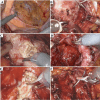Outcomes of lateral approach in robot-assisted radical prostatectomy: insights from a single-surgeon experience
- PMID: 38217830
- PMCID: PMC10787696
- DOI: 10.1007/s11701-023-01772-y
Outcomes of lateral approach in robot-assisted radical prostatectomy: insights from a single-surgeon experience
Abstract
In the era of robotic prostate surgery, various techniques have been developed to improve functional outcomes. Urinary continence has shown satisfactory results, but the preservation of lateral nerves to the periprostatic capsule is only achievable by sparing the pubovesical complex. This study aims to present the first cases of lateral-approach robot-assisted radical prostatectomy (LRRP) performed by a novice surgeon. We conducted a retrospective analysis of 70 prostate cancer patients who underwent LRRP between October 2019 and September 2021, analyzing the perioperative and functional outcomes. The median operative time and intraoperative blood loss were 102 (92-108) minutes and 150 (130-180) mL, respectively. Five minor postoperative complications were reported, and the median hospital stay was 2 (1-2) days. Eleven positive surgical margins occurred. Potency and urinary continence recovery were achieved in 59 (84%) and 66 (94%) patients, respectively, 12 months after surgery. Our analysis shows that LRRP is a safe and effective procedure for prostate cancer surgery. Continence and potency recovery required a short learning curve, with an acceptable recovery rate even in the initial cases.
Keywords: Erectile function; Lateral approach; Prostate cancer; Robot-assisted radical prostatectomy; Urinary continence.
© 2024. The Author(s).
Conflict of interest statement
The authors declare no competing interests.
Figures


Similar articles
-
Retzius-sparing Robot-assisted Radical Prostatectomy Leads to Durable Improvement in Urinary Function and Quality of Life Versus Standard Robot-assisted Radical Prostatectomy Without Compromise on Oncologic Efficacy: Single-surgeon Series and Step-by-step Guide.Eur Urol. 2021 Jun;79(6):839-857. doi: 10.1016/j.eururo.2020.05.010. Epub 2020 Jun 11. Eur Urol. 2021. PMID: 32536488
-
Is the learning curve of the urology resident for conventional radical prostatectomy similar to that of staff initiating robot-assisted radical prostatectomy?Int Braz J Urol. 2024 May-Jun;50(3):335-345. doi: 10.1590/S1677-5538.IBJU.2024.9909. Int Braz J Urol. 2024. PMID: 38446904 Free PMC article.
-
Urinary continence recovery after Retzius-sparing robot-assisted radical prostatectomy in relation to surgeon experience.J Robot Surg. 2023 Oct;17(5):2503-2511. doi: 10.1007/s11701-023-01687-8. Epub 2023 Aug 1. J Robot Surg. 2023. PMID: 37528286 Free PMC article.
-
Retzius-sparing versus standard robotic-assisted laparoscopic prostatectomy for the treatment of clinically localized prostate cancer.Cochrane Database Syst Rev. 2020 Aug 18;8(8):CD013641. doi: 10.1002/14651858.CD013641.pub2. Cochrane Database Syst Rev. 2020. PMID: 32813279 Free PMC article.
-
Preclinical and clinical evidence for using perinatal tissue allografts in nerve sparing robot assisted radical prostatectomy to hasten recovery of functional outcomes: a literature review.BMC Urol. 2024 Sep 28;24(1):208. doi: 10.1186/s12894-024-01593-7. BMC Urol. 2024. PMID: 39342266 Free PMC article. Review.
Cited by
-
Lateral Approach in Robotic-Assisted Radical Prostatectomy: Introducing Gaston's Technique in Brazil.Int Braz J Urol. 2025 Jul-Aug;51(4):e20250138. doi: 10.1590/S1677-5538.IBJU.2025.0138. Int Braz J Urol. 2025. PMID: 40327520 Free PMC article.
-
Recent Advances in Radical Prostatectomy: A Narrative Review of Surgical Innovations and Outcomes.Cancers (Basel). 2025 Mar 6;17(5):902. doi: 10.3390/cancers17050902. Cancers (Basel). 2025. PMID: 40075749 Free PMC article. Review.
References
-
- Gandaglia G, Leni R, Bray F et al (2021) Epidemiology and prevention of prostate cancer. Eur Urol Oncol. 4(6):877–892. 10.1016/j.euo.2021.09.006 - PubMed
-
- EAU Guidelines. Edn. presented at the EAU Annual Congress Amsterdam 2022. ISBN 978-94-92671-16-5.
-
- Ficarra V, Novara G, Rosen RC et al (2012) Systematic review and meta-analysis of studies reporting urinary continence recovery after robot-assisted radical prostatectomy. Eur Urol. 62(3):405–417. 10.1016/j.eururo.2012.05.045 - PubMed
-
- Ficarra V, Novara G, Ahlering TE et al (2012) Systematic review and meta-analysis of studies reporting potency rates after robot-assisted radical prostatectomy. Eur Urol. 62(3):418–430. 10.1016/j.eururo.2012.05.046 - PubMed
-
- Porpiglia F, Fiori C, Bertolo R et al (2018) Five-year outcomes for a prospective randomised controlled trial comparing laparoscopic and robot-assisted radical prostatectomy. Eur Urol Focus. 4(1):80–86. 10.1016/j.euf.2016.11.007 - PubMed
MeSH terms
LinkOut - more resources
Full Text Sources
Medical

